South Pacific e-Postcard #5
from Our Independent (formerly Western) Samoa Adventures
10/29 to 11/5/2006
Talofa (Hello). O a ami `oe? (How are you?)
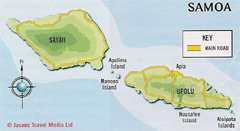
We are on Upolu, the main island of Samoa (pronounced SAM o a). Coming from temperate NZ, you are immediately greeted by lush tropical scenery, slower living, and heat. It always takes a few days to get used to the humidity, constantly wearing slightly damp clothes and sunscreen, drinking only bottled water, and watching the house gecko capture bugs at night. Samoa, however, has several features that distinguish it from the other tropical islands we have visited.
Q: How about the usual geography/geology/history lesson?
A: Samoa is located two-thirds of the way from Hawaii to New Zealand. It has two major islands (Upolu and Savai'i) and seven smaller ones. It is the larger part of an archipelago shared by American Samoa (which we visit next). The islands were formed by fast flowing lava over thousands of years. This makes the center of the island quite mountainous with steep river canyons reaching to the sea. The shoreline alternates black or tan sandy beaches with craggy, black rocky outcroppings.
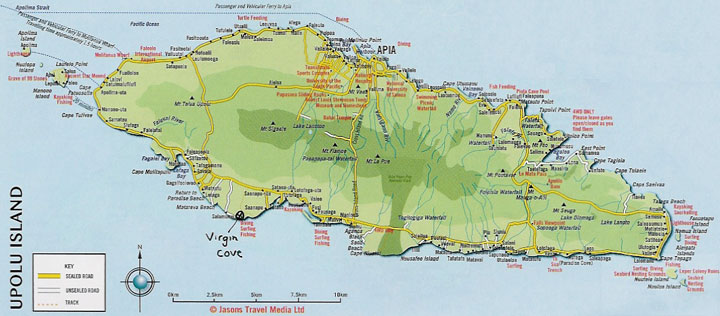
Samoa was first settled about 1500 B.C. by people from Tonga and Fiji. Samoan legend foretold of a new religion coming, so the Samoans quickly adopted Christianity when it arrived in the 19th century. In 1899, the Germans were given control of "Western Samoa" and the Americans got the rest as American Samoa. German rule was resented by the natives and lasted until Samoa was seized by NZ in 1919. The inept NZ government did little to prevent an influenza outbreak in 1919 that killed one-quarter of the natives. Obviously, NZ rule wasn't popular either, so, in 1962 Samoa peacefully gained independence. All throughout their history, Samoans have kept alive a very strong native culture known as fa'a Samoa (the Samoan way) and it is still evident today.
Q: What is fa'a Samoa (the Samoan way)?
A: Samoan culture is based on village life and respect for tradition. There are 362 villages in Samoa, each consisting of several extended families, a mayor/police chief appointed by the government, a main chief (who makes rules and judgments), and a talking chief (he actually talks for the main chief who is considered too mighty to talk to the common folk). Eighty percent of Samoan land is owned by villages. Most Samoans survive on the food they raise themselves. The members of the village share the work and profits; no one goes hungry or is neglected. If you won the Samoan lottery, you would share it with the village. If you need a watch, someone in the village would lend you his. The main source of income is selling extra agricultural products and, possibly, tourism. To use the beach or visit a natural site on land belonging to a village, one must pay a small custom fee (under $2 US). In return, sites and beaches are clean, well signed, and have changing/shower/toilet rooms if appropriate.
The typical family home is actually several buildings. The main house is usually one storey and contains sleeping quarters. There are openings for windows but there may not be any glass or screens as the people depend on the constant breeze to keep bugs away. The kitchen is a small, separate building. There is a elevated roofed building without walls (only columns holding it up) called the falo'o where the family may eat, meet, recreate, play, or nap.
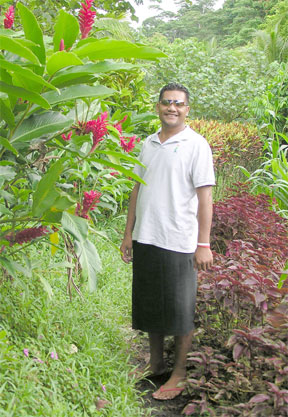 The falo'o can be quite large and very colorful with pull down mats for privacy. A larger, similar style building would be used for the village women to meet and do crafts and another for the chiefs to meet. A small elevated platform without walls, called a fale (fal-LAY) is used by visitors for sleeping.
The falo'o can be quite large and very colorful with pull down mats for privacy. A larger, similar style building would be used for the village women to meet and do crafts and another for the chiefs to meet. A small elevated platform without walls, called a fale (fal-LAY) is used by visitors for sleeping.
The married sons and their families move into the house of the parents (or nearby) and divide the property at the parents' deaths. Native people are buried on their property with decorated open-air houses over the graves. Non-natives use cemeteries. Chiefs are buried in small stepped pyramids by their home. There are lots of churches (all Christian-based) strongly supported by the villages, sometimes to the village's financial disadvantage. At 6 p.m., many of the villages stop for family prayer (about 15 minutes). If you are driving through the village at that time, you must stop and remain in your car until prayer is over.
The village men wear a skirt-like cloth wrapped around them called a lava-lava. Even businessmen and police in the city wear lava-lavas (and the inevitable flip-flop sandals called jandals). Village women wear skirts or muumuu dresses. Tourists in beachwear (other than on the beach) and women in shorts or slacks are looked down upon in the village. Although the dress code is more relaxed in the city, many of the teenagers and young men wear lava-lavas proudly. All school kids through high school wear uniforms (shirts, skirts, lava-lavas) in the school colors. Traditional tattooing for men was covering everything from waist to knees. Although that is no longer prevalent, many young men and women get tattoos of cultural symbols on their arms or legs.
There is an extremely strong pride in fa'a Samoa. Many tourist activities are arranged around showing the Samoan way. A lot of Samoans live abroad but many return at Christmas time to renew fa'a Samoa.
Q: How is the food?
A: Well, it varies. The island breakfast here seems to consist of fruit (several types of bananas, papaya, mango, and coconut), bread or toast, tea or coffee, and something served in a bowl. So far, this "something" has been one of the following: cooked rice with coconut cream and cocoa (a kind of mushy Cocoa Krispies), mashed bananas with coconut cream and a kind of tapioca (this is good but a slimy grey in appearance), rice and coconut cream, or mashed papayas with coconut cream and tapioca. We never know what will be in the bowl (even after we get it). But, it usually tastes quite good.
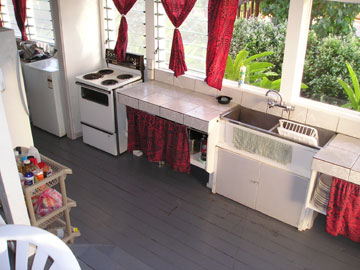
The supermarkets seemed rather poorly stocked to us. Then we realized that many people either raised their own food or shopped at the fruit/vegetable and fish market. There are few dairy products and no cattle are raised for milk here. Based on the grocery displays, the people seem to have a love of canned "meat". These cans contain pork product (like Spam), lamb tongues, veal tongue, corned beef, or others. The funny thing is the picture of the product on the labels all look the same.
Twice we went to the local food halls for lunch. We were the only tourists there but it was packed with locals, many getting carry out food. For about 3 tala ($1.20 U.S.), you got a large plate of rice with chicken curry, stir fry, or egg foo yung. The chicken was in big chunks with the skin and bones still on, the stir fry had fatty mutton in it and the egg foo yung contained some of that unnamed canned meat. This is definitely a cultural difference. We try to be open-minded and try foods unusual to us, but these were not appetizing! Needless to say, we either cooked at our hostel or ate at a more "European" restaurant. Thank goodness, they still had Coca-cola! (The main drink of the locals as well). And, of course, we are not losing weight.
Q: What have you been doing?
A: In Samoa, we are staying in two places, completely opposite in location and character.
Princess Tui Inn: In the north, we spent four days in a home built in 1849. It is now a bed & breakfast with private ensuite rooms (having a bathroom) and dorm hostel rooms. The Inn was about a half mile outside of Samoa's capital, Apia. We arrived very early Sunday morning (4 a.m.) and the whole town was closed all day except for a couple of restaurants. We took the hint and napped much of the day. Come Monday, things were bustling.
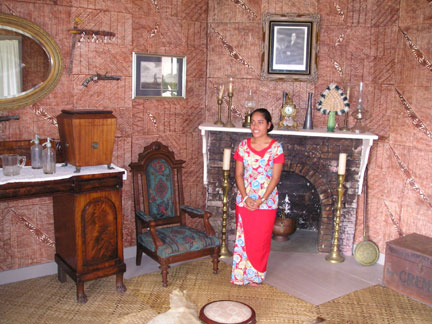
We spent some time walking around town doing errands then took a local bus up into the hills. The bus was windowless with wooden benches and a low ceiling (as Tim found out). On the way, it dropped off a man who had stored three woven baskets full of breadfruit beneath the bus to sell at the market. You pay the driver on the way out....no wonder I had to force the money on him when I got on. The bus took us to Robert Louis Stevenson's (RLS) home high above the town. Although furnished mostly with reproductions, it was interesting to see how an European lived in Samoa during the 19th century. It was a huge and airy home with a nearby spring. He only lived here the last five years of his life, dying at age 44. As RLS helped the Samoans in their fights with competing tribes, he was much loved. His funeral procession had hundreds of natives honoring Stevenson Tusitala, the "teller of tales".
Almost across the street from the Inn is a marine reserve with some interesting snorkeling. Although there weren't any new fish for us to see, there was quite a variety of coral. It is always great to be able to walk to a beach to snorkel.
Although in the past, we have rented a car or scooter to go around the island. In Samoa, it was suggested that we hire a taxi driver who spoke English well and would take us around, stopping wherever we like. So, for the price of the rental car plus gas (about $80) we spent a delightful day seeing the eastern Samoa with PJ. He patiently answered our questions and told us about the culture of Samoa from a local's point of view. PJ also knew a lot of legends and origins of place names. There was a huge crevasse named after the abandoned wife who jumped into it holding her baby. And a town named "Eye of the Wind" which is always the first to get hit by tropical storms. We saw waterfalls and interconnected lava tubes filled with water. One village had men along the coastline watching a large wooden fence they had built in the sea. Some men were atop a shaky lookout tower on land, others atop a tower in the water. When a school of special fish came into the area, the men in the towers signaled and the gate to the fence was closed, capturing the fish. This only happens a couple times a year and only in this village. Fish the village does not use sell for a very high price at the market.
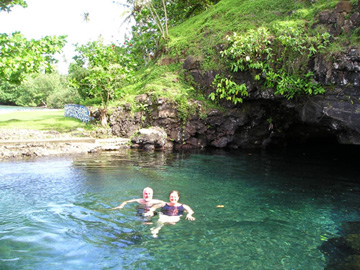
There was a quick stop at a Baha'i main temple (one of only seven in the world). It was a round church-like building with no ornamentation but surrounded by a beautiful tropical contemplative garden. The Baha'i followers believe that all religions are important and equal, there is one Supreme Being, that education should be universal, and that justice is a cornerstone of all civilizations. Throughout history, they believe, that many holy people have arisen to spread the word of the Supreme Being: Moses, Abraham, Christ, Mohammed, Buddha, etc. The foundation is that different religions should be a unifying factor, not a basis for conflict. Food for thought in this time of international strife.
We stopped midway and snorkeled off a lovely beach. Again, the coral was abundant but the fish not very colorful. Our last stop was a cave with a freshwater pool just a few feet from the sea (see attachment). It was connected to another pool via a short, underwater tunnel. Fellow travelers and our guidebooks assured us that, after finding the entrance to the tunnel, it was an easy trip through. Tim found the entrance with the help of his underwater flashlight, but decided (wisely, I think) that the tunnel was too narrow for him. If he got stuck, it would be a disaster. Of course if Tim though it was too narrow, Di wouldn't have a chance! You know, discretion is the better part of valor.
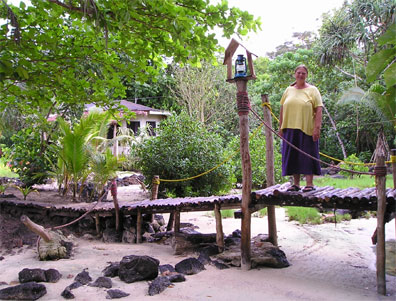
Virgin Cove: The last half of our Samoan visit was spent in the south of the island at an "eco-resort". This place consists of twelve fale (thatched huts without walls or running water built on platforms by the sea) and three bungalows (roof, walls, hot water and solar power). Yeah, we're wimps! We opted for the bungalow! However, there will be a fale in our near future in American Samoa. Virgin Cove Resort is nestled between a mangrove forest and the ocean. To get to our bungalow you cross over the mangrove stream on a small primitive bridge. At night, outdoor lighting in the eating area is by candlelight and along the paths home by kerosene lamp. If I fall off the bridge at night, Tim said it would be easier to dry me off than find the key (what a guy).
This place is remote and once you are here, you can't easily leave during the day....nor do you want to. All the meals are provided so you can spend the day sleeping, swimming, sunning, snorkeling, reading or wandering around. The hours float by and one can lose track of the real world here. We were entranced by the burrowing crabs just outside our porch and how they challenged each other for the best holes. Three house geckos lived with us and their behavior was amusing as well. Each day the resort staff does some Samoan cultural activity like weaving baskets of coconut leaves. So far, we've seen the coconut used as food (raw, coconut cream, ice cream), the leaves for baskets or plates, the branches for roofing, the shells for bowls, and the trunk fiber for rope and weaving fabric. No wonder each village has a coconut plantation lovingly tended. Too bad we can't have one of them (or a house gecko) in Michigan.
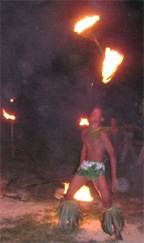
The food is great with lots of Samoan fruits. A constant, besides coconut, is taro. Taro is a starchy root cooked like potato. It is somewhat bland but is served with sauces and in soups. We also had unripe, green bananas cooked and served with a coconut cream gravy - quite good.
The last night at Virgin Cove was "Island Night". After a starter (appetizer) of fish on taro slices and taro leaves (like spinach) on taro slices, we were entertained by a young native group. They sang and danced to music from Samoa, Hawaii, French Polynesia, and the Cooks. It was like a review of the islands we had visited. The women did some very fast hip shaking movements, like a high-speed hula. The men danced even faster with jumps, kicks, and yells designed to intimidate the enemy. One act involved two young men who danced over and even sat on wooden crates that were on fire - a couple of times they had to roll on the ground to put out their palm leaf lava-lavas! The highlight was a fire stick performance. Imagine two boys twirling sticks that are on fire at both ends. Di (as a former mediocre baton twirler) was very impressed with their speed and agility. The entire performance was lit only by torches and candles, making the evening a wonderful way to end our visit to Samoa.
Tomorrow we head for our fale in American Samoa, where the currency is the familiar greenback and we know Coca-cola is also available. Hope all of you are well. Fa'afetai (thanks) for reading and Tofa (goodbye).
Di & Tim
 The falo'o can be quite large and very colorful with pull down mats for privacy. A larger, similar style building would be used for the village women to meet and do crafts and another for the chiefs to meet. A small elevated platform without walls, called a fale (fal-LAY) is used by visitors for sleeping.
The falo'o can be quite large and very colorful with pull down mats for privacy. A larger, similar style building would be used for the village women to meet and do crafts and another for the chiefs to meet. A small elevated platform without walls, called a fale (fal-LAY) is used by visitors for sleeping.






